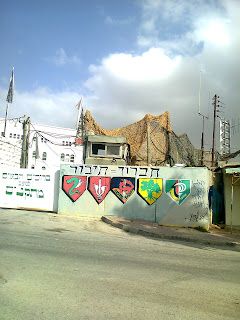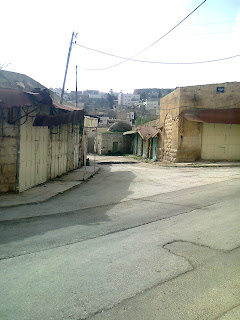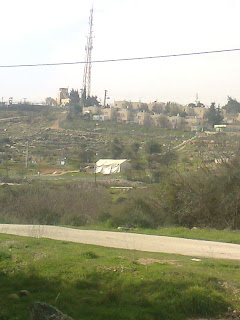This past Monday, Myself along with my fellow Tikkun Olam in Tel Aviv participants and friends went on a guided tour through Breaking the Silence in Hebron. For those that do not know what Hebron is, it is a city located in the southern part of the West Bank, or Occupied Palestinian Territory, really which ever you want to call it. It is an important city in the Monotheistic religions due to the Tomb of the Patriarchs. In Hebron, it is said that Abraham had bought a cave for the burial place of Sarah. Later the Patriarchs and Matriarchs, with the exception of Rachel, were to be buried there. It was also the capital of King David's Kingdom before he moved it to Jerusalem. Today politically speaking, the city is a microcosm of the conflict. Hebron is interesting in that it is also a settlement, as well as a Palestinian city with most of its Jewish settlers living in Kiryat Arba, and Area H2. Area H2 is the designated Israeli controlled area of the city under the Oslo Accords, while the rest of Hebron is in Area H1 and Palestinian Authority control. With that said, there is more to the history which I will get to later on Hebron.
We were guided through the city on a tour with a group called Breaking the Silence. Breaking the Silence is a peace organization which takes personal accounts of Israeli soldiers of their time spent serving in Hebron and the rest of the West Bank. Besides collecting personal testimonies, they give tours of Hebron to Israelis, and foreigners.
With some background information on Hebron and Breaking the Silence, the real information is coming now. We learned that Hebron for much of its history had a Jewish community. It had waves of Jewish life including Sephardi Jews coming and settling after the Spanish Inquisition. This Jewish community however declined and ceased to exist in fact after a massive riot perpetrated by the Arab population of the city. It is claimed that it was incited by the Grand Mufti of Jerusalem at the time Haj Amin Al Husseini. The riot was a massacre. The lives of 67 Jews were taken during the riot. There would be zero Jewish presence in the city besides one person until 1968. This Jewish presence would not have been possible if it were not for the IDF's incredible victory in the Six Day War in 1967. A group of Religious Zionist Israelis were allowed to spend the Pesach(Passover) in 1968. They did not leave after Pesach, and created a settlement in Hebron around Beit Hadassah, which used to be a hospital up until the 1929 massacre. Most of the Israeli settlers living in Hebron live in the main settlement of Kiryat Arba, which is on the outskirts of the city and has a population of around 7,000. For the Israeli Settlers, they are governed under civilian administration. the Palestinians however are under Military occupation in H2 and Palestinian Authority rule in H1. This means that there are two different sets of laws for the residents of the city. Tension between the settlers and the Palestinians would begin with settler violence in 1994 when Dr. Baruch Goldstein went into the Muslim section of the Tomb of the Patriarchs are began shooting. He would kill 29 before being murdered by onlookers. This would begin a period in time of inter communal violence, not to mention the Second Intifada. Now, much of the market is closed. the main commercial street of Hebron Shuhada St. is closed Palestinian traffic. The city now is experiencing over 70% unemployment. It is a empty town filled with people. It is surreal. It is like a completely different world. To know that the city market is closed due to violence perpetrated by Settlers on Arabs, and Arabs on Settlers is horrible to know. Its terrible to know fellow Jews can perpetrate such atrocities is even more disgusting. Later on in the day we met with a Palestinian peace activist by the name of Issa. It was a very emotionally charged visit. I could tell by his tone of voice how he yearned for freedom. For a country of his own. For the reopening of the market. For Hebron to be a place he is proud of. We also went to the Tomb of the Patriarchs. It was different from any other religious Jewish site I have been to. I wished to see the tombs, but apparently they are located in the Muslim section which is closed to non Muslims. It did not seem to evoke the same feelings as the Kotel does. It seemed quiet and quite odd. We also met with a representative of the Jewish community in Hebron. We learned about the history of Jewish Hebron and what the situation is like for them.
When the day ended, I was glad I had the opportunity to have been in Hebron. For me, seeing the city market empty was heartbreaking. To know that because of violence this place is empty. It kills me. This is why there needs to be dialogue between Israelis and Palestinians. Hebron is the reason for Palestinians and Israelis to return to the negotiation table. During my time in Hebron, my friends and I saw Palestinian men and children come up to us and grab what ever they could, tried to sell us trinkets, and even bluntly said give me money. It is horrible to see this children and men doing such things. This however is the situation. It makes me hope for a brighter future, for both Israelis and Palestinians and the hope that they can live side by side be it in their own states.
































No comments:
Post a Comment